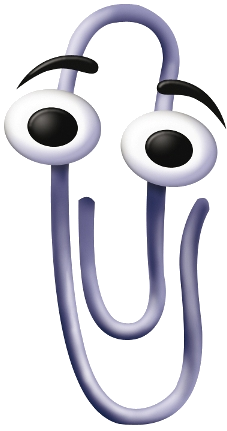

For instance, typing an address followed by "Dear" would cause Clippy to pop up with and a variety of pre-determined messages, including "Hey! It looks like you're writing a letter!" before offering to help walk you through the process. Atteberry to serve as a user-friendly troubleshooter for people using Office applications including Word and Excel. The shape functions available are polygon(), circle(), inset() (used to define inset rectangles), and ellipse().Īpplying a clipping path to an element using the clip-path property is very simple and straightforward: /* Referencing an SVG clipPath */Ĭlip-path : polygon (.Clippy, a paperclip with googly eyes and expressive eyebrows, was designed by Kevan J. These shapes can be created using shape functions.

You can also define a clipping path using one of the basic shapes defined in the CSS Shapes module. Using clip-path, you can apply an SVG to an element by referencing that path in the property value. The clip-path property is used to specify a clipping path that is to be applied to an element. The clipping operation has been a part of SVG since 2000, and has moved into the CSS Masking module so that it now allows clipping HTML elements as well as SVG elements. The clip-path property is part of the CSS Masking Module.
Clipy form word how to#
If you want to learn more about how to do that, you can check the articles I wrote about this topic. If you want to change the way the content around the element flows and have it respond to the defined shape of the clip path, you can use the CSS Shapes properties. It influences what parts of the element are rendered on the screen, but it does not affect the element’s inherent geometry-the element will affect the flow around it as it normally would, and every other element on the page will still see and treat the element as if it were still rectangular, even if it’s clipped to a non-rectangular shape. The clipped element can be any container or graphics element.Ī clipping path is conceptually equivalent to a custom viewport for the element it applies to. This includes any content, background, borders, text decoration, outline and visible scrolling mechanism of the element to which the clipping path is applied, and those of its descendants. Any parts of the element that lie outside of a clipping region are not drawn. This region is known as the clipping region. The portions of the element that are shown or hidden are determined by a clipping path.Ī clipping path defines a region where everything on the “inside” of this region is allowed to show through but everything on the outside is “clipped out” and does not appear on the canvas.

The clipped element can be any container or graphics element.
Clipy form word code#
I'm also not including any vendor prefixes in the code samples here, but they are included in the live demos.Ĭlipping is a graphical operation that allows you to fully or partially hide portions of an element. The purpose of this article is to go over how clipping works in CSS and SVG, and serves as a reference for when these features are fully implemented. Not all clipping features are implemented and some features may be buggy. You don't need to view the live demos to follow up with the article. You should check this compatibility table out for more information. Please note that the demos in this article may not work in your browser. In this article we will go over the clipping techniques in both CSS and SVG, covering everything you need to know to get started. Both CSS and SVG allow us to "clip" elements into custom non-rectangular shapes. One of these features is the Clipping operation. A lot of the features that we have in CSS today were imported from SVG. clip-path Notes: Stacking Contexts, Pointer Events and AnimationsĬSS and SVG have a lot in common.Clipping in CSS – The clip-path Property.


 0 kommentar(er)
0 kommentar(er)
